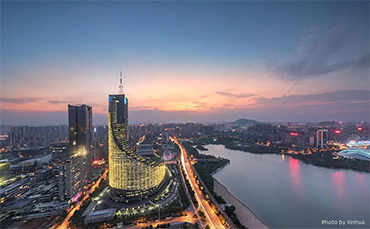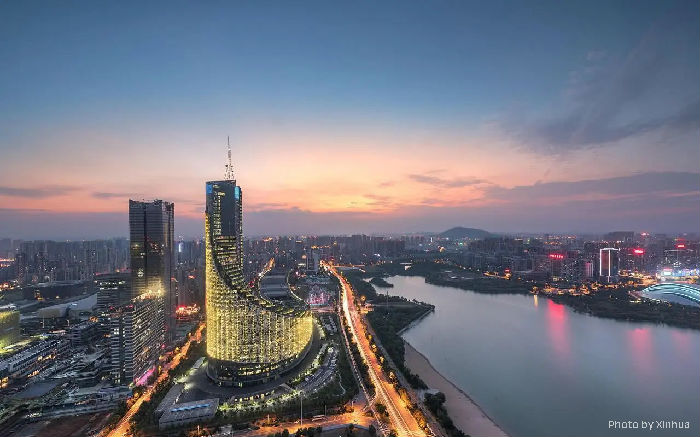



A view of Nanjing. [Photo/Xinhua]
The full text of the "Nanjing Metropolitan Circle Development Plan" was released on April 16, 2020. The "Nanjing Metropolitan Circle Development Plan" was approved by the National Development and Reform Commission and officially issued by the Jiangsu and Anhui provincial people's governments, becoming the first Metropolitan Circle development plan approved at the national level.
As the pioneer of Metropolitan Circle in China, the Nanjing Metropolitan Circle has gone through 20 years of development in process of extensive consultation and joint contribution of related cities.
Entering a new development stage, in the first year of the 14th Five-Year Plan Period, the "Nanjing Metropolitan Circle Development Plan" was approved by the National Development and Reform Commission. On March 22, the Plan was officially issued by the Jiangsu and Anhui provincial people's governments, becoming the first Metropolitan Circle development plan approved at the national level, marking the construction of Nanjing Metropolitan Circle to a new strategic perspective.
On April 16, Jiangsu Provincial People's Government and Anhui Provincial People's Government jointly held a press conference on "Nanjing Metropolitan Circle Development Plan", the Plan was officially released to the public.
LIN Kang, deputy director of Jiangsu Provincial Development and Reform Commission, introduced that during the preparation process of the Plan, we focused on serving the major national strategy, profoundly grasp the construction regular pattern of the Metropolitan Circle, and carried out systematic and pragmatic plans for the development of Nanning Metropolitan Circle based on actual situation. The main contents of the Plan can be summarized as follows: a spatial structure, two key elements, two development stage aims, four positions, eight major tasks and two sets of guarantee mechanisms. It includes the preface, 12 chapters, 38 sections and 14 columns, with a total of more than 30,000 words.
Determining a practical and proper planning spatial structure is based on some certain context.
According to the development experience of major metropolitan circles in the world, the scope of Nanjing Metropolitan Circle is reasonably defined based on the practical development, scientific analysis of current data such as commuter and migration, the history of regional cooperation and development potential. The Nanjing Metropolitan Circle includes the following cities: Nanjing, Zhenjiang (Jingkou District, Runzhou District, Dantu District, and Jurong County-level City), Yangzhou (Guangling District, Hanjiang District, Jiangdu District, and Yizheng County-level City), and Huai'an (Xuyi County) in Jiangsu Province; Wuhu (Jinghu District, Yijiang District, and Jiujiang District), Ma'anshan (Huashan District, Yushan District, Bowang District, He county and Dangtu County), Chuzhou (Langya District, Nanjiao District, Lai'an County, and Tianchang County-level City), and Xuancheng (Xuanzhou District) in Anhui Province. It covers an area of 2.7 square kilometers with a population of 20 million. The Circle range from Nanjing to the adjacent cities' administrative regions including Zhenjiang, Yangzhou, Huai'an, Wuhu, Ma'anshan, Chuzhou, Xuancheng, and Jintan District of Changzhou as well as Liyang. Considering the difference of regional resource and overall development potential, the spatial structure of metropolitan circle is identified as "One Core City, Two Areas, Four Belts, and Multiple Clusters" under the leading effect of core city and integrated urban areas, with providing radial and axial influence, and supporting from difference aspects, making best of the current situation and looking forward to the future development.
"One Core City" is the premium level in the metropolitan city hierarchy, namely Nanjing city. Nanjing should emphasize providing radial urban service and role-modeling to other cities.
"Two Areas" are the two integrated urban areas of "Ning(bo)-Zhen(jiang)-Yang(zhou)" and "Ning(bo)-Ma('anshan)-Chu(zhou)". These two integrated urban areas should speed up united urban construction and set a pilot model for surroundings.
"Four Belts" are the four development belts centered on Nanjing. They are: the innovation service hub development belt of Shanghai-Nanjing-Hefei towards Shanghai, with a close connection with the comprehensive national scientific center in Shanghai and Hefei, which should accelerate innovation-driven and transformation-upgrading; the green and intelligent manufacturing development belt along the Yangtze River, with the promotion of resource integration and green transformation, which should emphasize the radial function to Wanjiang Urban Belt and even the Upper and Middle Reaches of the Yangtze River; two ecological economic development belts of Ningbo-Huai'an-Xuancheng and Ningbo-Hangzhou-Chuzhou will unblock the path from north to south, with the integrated delivery of ecological industrialization and industrial ecologicalization.
"Multiple Clusters" are counties and major towns in the Circle. These clusters should enhance the integration of planning, and develop together as a whole with functional definition.
Focusing on urban integration and high-quality development.
Entering a new era of development, it is vital to implement the new development concepts and establish a new development structure to focus on the development of urban integration which is the key point of metropolitan circle construction. Emphasizing the aims of "urban integration" and "high-quality" in the planning process, insisting on the theme of promoting high-quality development are mentioned in the Plan. The main theme is to further supply-side structural reform. The original aspiration is reform and innovation. It is the point to focus on the urban integration development of the central city and surrounding cities. Steadily improving the institution of urban integration development is important to achieve breakthroughs, and finally to develop the Nanjing Metropolitan Circle as a modern metropolitan circle with national influence.
Clear generating the development vision of the Circle with great foresight.
Take the national major strategies of the integrated regional development of the Yangtze River Delta and the building of Yangtze River Economic Belt as the overarching principle; Concentrate on the demonstration of nationwide modern metropolitan circle building; Systematically review the potential advantages towards future regional competitions; Research and propose the strategic positioning of "one highland-one center-one zone-one circle", specifically: one influential industrial innovation highland, one resource allocation center of Yangtze River Economic Belt, one demonstration zone of national urban integration development, and one high-quality livable life circle. With the strategic positioning, based on the basic conditions of Nanjing Metropolitan Circle, the development aims are divided into two stages to reflect the demands of the modern metropolitan circle under thoughtful considerations and possibilities. The first stage is to target the national level。 By 2025, urban integration will be a leading model and the comprehensive infrastructure will be enhanced dramatically with the real GDP per capita of over ?150,000. The second stage is to target the world level. A modern metropolitan circle with international influence will be basically built.
Collaborating for accelerated issues solving in the important field.
In accordance with the metropolitan circle strategy and development vision, to focus on urban integration, high-quality, to insist on highlight the advantages, collaborative construction, and jointly development, the major tasks and key measures of metropolitan circle development is identified as 8 aspects including infrastructure, scientific innovation, industrial collaboration, opening-up and cooperation, integral market, public services, ecological environmental protection, and urban-rural integration. They are specified as follows.
For infrastructure: focusing on solving the issues of "dead end" and "traffic bottleneck", developing a convenient national transport network, framing an "accessible metropolitan circle" and a "smart metropolitan circle".
For scientific innovation: focusing on jointly building of Research-R&D-Application innovation chains and industrial innovation centers, and creating innovation metropolitan circle and technology-creation community together.
For industrial collaboration: focusing on supporting the development of branding industries, initiatively planning the spatial structure of different industries, division of labor and collaboration, characteristic development, and establishing a modern industrial system together.
For opening-up and cooperation: focusing on providing comprehensive service for the implementation of national major strategy, and jointly building a number of high-level opening-up platforms and business-friendly highlands to form an "opening-up metropolitan circle".
For integral market: focusing on the clearance of administration separation, market barriers and industry monopolies, unifying market access standards, and accelerating the building of integral human resources market, technology market, and financial capital market.
For public services: the point is to promote the integral development of education and medical care, cultural tourism, employment, social security, and regional governance, to accelerate and improve high-quality and common public service to everyone, and to jointly deliver a building a happy metropolitan circle.
For ecological environmental protection: focusing on establishing and improving the framework of ecological environmental jointly protection and management, collaborating and promoting the ecological protection and restoration as well as the environmental pollution control to create a green metropolitan circle.
For urban-rural integration: focusing on the promotion of rational allocation of urban and rural elements across regions, collaborative constructing modern cities and characteristic rural villages to be a demonstration model of urban-rural integration.
Reforming and innovating in the construction system to ensure the development of the metropolitan circle.
The key to develop a modern metropolitan circle is the complete removal of administrative and institutional barriers. In response to the problem of numerous local governments of Nanning Metropolitan Circle, which includes 33 counties or districts under 8 cities in 2 provinces, abandoning the traditional mentality of minding one's-own-business and fully relying on the three-level operational institution are vital. The reforms of negotiation, cooperation, and management system need to be strengthened. Building two mechanisms of "urban integration development" and "planning implementation" should be accelerated. The establishment and improvement of development mechanism including regular negotiation, policy coordination, cost-sharing and benefit-sharing, cross-border integration should also be concentrated, and the planning implementation mechanism which specified as the identification of tasks of different stakeholders, the delivery by leading practical administrative institutions, financial supports by all levels of local governments, and comprehensive social participation is synchronized to ensure that every major task of the development of metropolitan circle will see implementation.
Source: <https://mp.weixin.qq.com/s/qa1mliWPyNYsVdnK_fvfBA>
Translated by GUO Xinxin